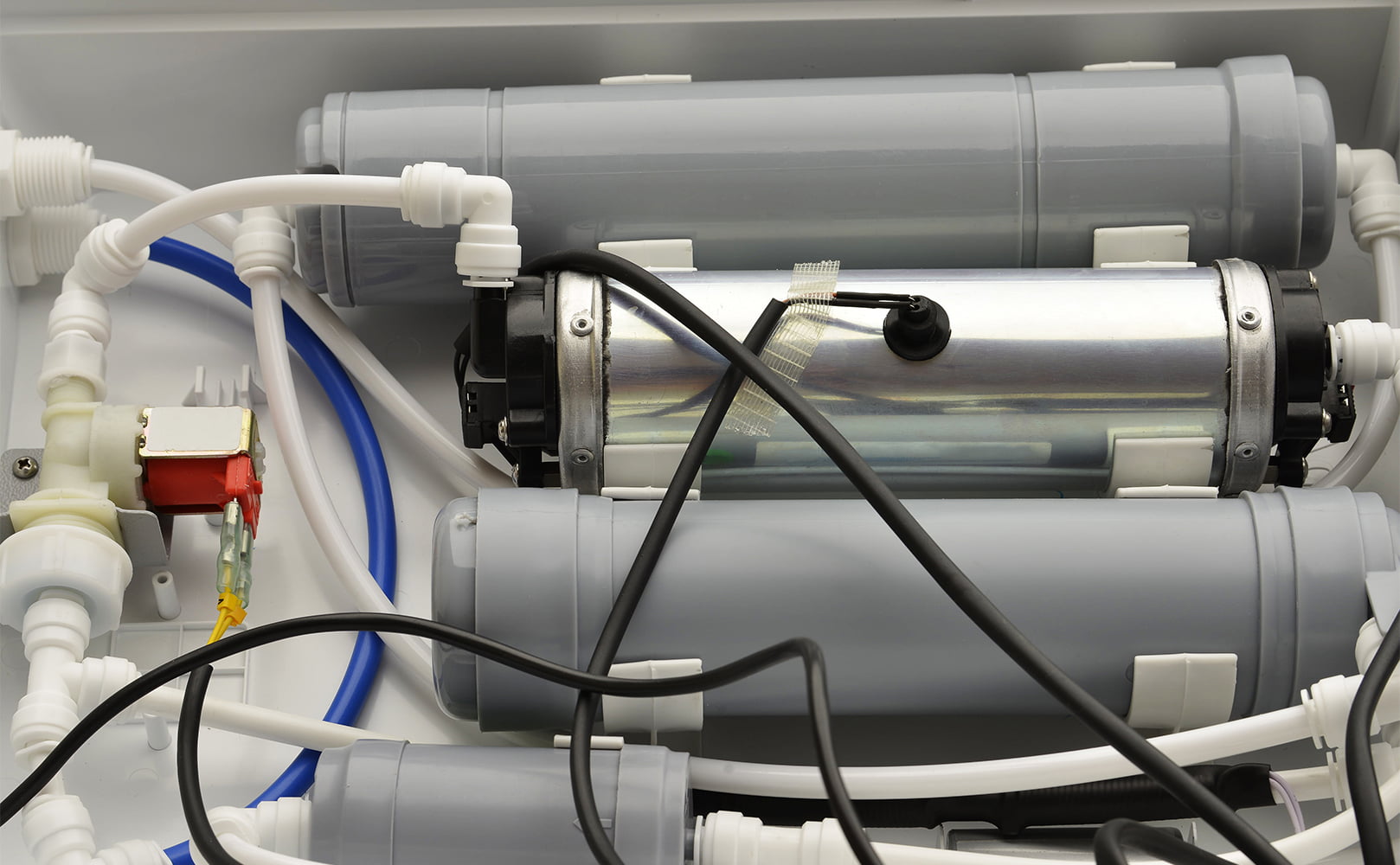What Is a UV Water Purifier and How Does It Work?
Written by: Gene Fitzgerald // Last Updated: Jan 4, 2023
This page may contain affiliate links. If you buy a product or service through such a link we earn a commission at no extra cost to you. Learn more.
Many households utilize a UV purifier for disinfecting their water supply. It’s an especially popular solution in areas with high rates of biological contamination. UV purifiers are popular for their high rate of effectiveness and low maintenance.
Despite their relatively simple design, they work great at killing most waterborne microorganisms and can be easily serviced by users without any technical experience.
Key Takeaways
- A UV water purifier is a tube-shaped device usually attached to the household’s plumbing, which disinfects all water that passes through it by exposing it to UV light.
- UV water disinfection works because a short exposure to UV rays of the right wavelength (254 nm) scrambles a microorganism’s DNA and kills it with extreme effectiveness.
- Under ideal conditions, a UV purification system can neutralize up to 99.9999% of microorganisms in a water supply.
How UV Water Disinfection Works
UV water disinfection relies on the fact that UV light is deadly to most microorganisms. Short exposure to UV rays of 254 nm wavelength scrambles their DNA and effectively kills them with extreme effectiveness.
Under optimal conditions, a UV purification system can neutralize at least 99.99% of microorganisms in the water supply. This requires the absence of any suspended particles in the water, though. Solids can reduce the effectiveness of UV purification systems, so they may need additional pre-filtration steps for optimal efficiency.
What Is a UV Water Purifier and How Does It Work?
So, what is a UV water purifier and how does a UV water purifier work?
A UV water purifier is a tube-shaped device that’s usually attached to the household’s plumbing and filters all water that passes through it by exposing it to UV light.
The standard design of a UV water purifier features a long UV light bulb that sits in the middle of a large encasing chamber through which all water passes. The bulb is encased in a transparent material – typically quartz – to isolate it from the water while still allowing UV rays to pass through.
Types of Systems
UV purifiers are mostly categorized according to their strength. Most domestic units use a standard UV lamp which is enough to disinfect water with a low to medium flow rate, which is common for most households.
In commercial settings, a purifier with a high-output UV lamp might be used instead. These models can handle a higher flow rate without compromising their disinfecting qualities. They also consume more power and are more expensive.
Some models may also utilize special UV lamps with vaporized mercury for an even higher output. Those are typically found in environments with very high flow rates.
Another way of categorizing UV water purifiers is in whole house and point of use systems.
What Are the Components of a UV Water Purifier?
UV Lamp
The main component of a UV water purifier is the UV light bulb. It’s an elongated bulb that runs along the full length of the purification unit and emits light radially in all directions.
Quartz Glass Sleeve
The bulb is encased in a quartz glass sleeve. Quartz is used instead of regular glass due to its higher ultraviolet light transmittance. Ordinary glass absorbs a larger portion of UV light and suffers from a solarization effect when exposed to it for prolonged periods, which decreases the effectiveness of the purifier.
Main Chamber
The quartz sleeve is surrounded by a larger encasing chamber, sometimes called the reactor chamber. Water flows through that chamber and gets exposed to the UV light emitted from the bulb in the middle. Connecting seals at each end of the chamber allow it to be hooked up to the water supply of most households.
Control Unit
Most UV purifiers also feature a control unit which manages the operation of the light bulb. Simple models just turn the bulb on and off as power is supplied to the unit. More advanced models may have additional features, like a UV light level sensor, light bulb change timer, and an alarm that signals that the unit is powering off.
What Does UV Water Disinfection Remove?
UV disinfection exclusively targets microorganisms. It kills them with a high rate of success, almost completely sterilizing the water supply. However, that’s all a UV purifier does. It does not remove any chemicals, salts, heavy metals, or other contaminants from water.
In fact, a UV purifier’s effectiveness is affected negatively by the presence suspended solids in the water. They create shadows that allow some of the microorganisms to hide behind, passing through the purifier unharmed. In this case, to ensure optimal operation of a UV purifier, water needs to be run through additional pre-filters before it reaches the purifier.
It’s also important to note that microorganisms aren’t physically removed from the water. They are simply killed, but their dead bodies will remain in the water until they are filtered out through other means.
UV purifiers are also ineffective in addressing foul taste or odor in a water supply.
When and Why to Use a UV Light Purifier
Using a UV purifier is always a good idea when biological contamination of the water supply is a concern. This is especially important for households supplied directly from a well.
Ideally, a UV purifier should be the last purification step applied to a home’s water supply. Running the water through additional filtration (especially ones that remove suspended particles) improves its efficiency and the final quality of the water.
Users who’re not sure if their household requires a UV purifier are advised to have their water supply tested. This can reveal the presence of any bacteria and other potentially harmful microorganisms. Even if the test doesn’t show any worrying results, it’s often advised to invest in a UV purifier for the long term. That way, the household can be prepared if the situation deteriorates in the future.
Advantages and Disadvantages of UV Water Purification Systems
What are the advantages and disadvantages of UV water purification?
Advantages
- No chemicals used. UV purification doesn’t use any chemicals – in fact, water doesn’t come in contact with anything other than the internal lining of the main chamber.
- Highly effective. With a 99.99% disinfection rate under optimal conditions, UV purification is one of the best methods for treating home water supplies on the market.
- Simple design. No moving parts, no complex electronics (other than the controller), and nothing that requires advanced technical skills for servicing. Other than replacing the quartz glass sleeve and UV light bulb once a year, a UV purifier needs practically no maintenance.
- Standard UV purifiers use very little power. The UV bulb itself is the only component that needs electricity in the whole setup, as a UV purifier doesn’t use any pumps in its operation.
Disadvantages
- Doesn’t remove anything from the water supply UV purifiers are designed to kill microorganisms and they do that very well. But they don’t actually remove anything from the water – not even the dead bodies of those microorganisms. Therefore, UV water purification usually works best when combined with additional treatment steps.
- Requires additional pre-filtration. If water is not filtered before it reaches a UV purifier, it can have a negative impact on the purification effectiveness. Any suspended particles left in the water can obstruct UV rays and prevent them from hitting all microorganisms as they pass through the chamber.
- Doesn’t work without power A power outage won’t leave the house without water, as a UV purifier doesn’t need pumps to operate. It will, however, prevent the purifier from disinfecting. This can be especially problematic in scenarios where power goes out only partially, affecting the purifier but no other appliances in the household. Users might end up drinking contaminated water for a prolonged period until they realize the purifier has not been working.
Are UV Purifiers Safe and Effective?
When installed and used correctly, a UV purifier can greatly increase the safety of a household’s water supply. This mostly comes down to proper pre-filtration and regular maintenance.
As we mentioned above, pre-filtration is needed because any solids in the water supply will decrease the effectiveness of the UV purifier.
Water may also need to be softened before it reaches the purifier. While hard water doesn’t interfere with its operation directly, it will cause the quartz glass sleeve to fog up more quickly, requiring more frequent maintenance.
Failing to regularly clean and/or replace the quartz glass sleeve can also lead to a decline in the purifier’s effectiveness. A UV water purifier works best when its quartz sleeve is as clear as possible. Any buildup on it can partially absorb UV rays as they pass through, preventing them from targeting all microorganisms in the water supply.
How to Maintain a UV Water Treatment System
Proper maintenance of a UV water purifier is crucial for its effective operation. One of the great aspects of UV purification is that it requires relatively little maintenance compared to other water disinfection methods.
Maintenance is mostly focused on two components: the UV light bulb and its encasing quartz glass sleeve. Most UV bulbs lose about 40% of their intensity within 9,000 hours of continuous operation. Therefore, the bulb should be changed roughly once a year.
Users also need to regularly clean the quartz glass sleeve and monitor it for permanent fogging. Cleaning the sleeve annually should be enough to deal with most build-ups. After some time, however, the sleeve will start to fog up permanently, and will eventually need replacement. This should ideally be done once every two years.
The sealing rings at each end of the purification unit also need to be checked regularly. They normally last a long time without leaking, but even the tiniest leak should be addressed immediately as it can quickly propagate into a much more serious problem.
If you have any thoughts about the question, what is a UV water purifier and how does a UV water purifier work, please don’t hesitate to leave a comment below!
Information provided on BOS is for educational purposes only. The products and services we review may not be right for your individual circumstances.
We adhere to strict editorial guidelines. Rest assured, the opinions expressed have not been provided, reviewed, or otherwise endorsed by our partners – they are unbiased, independent, and the author’s alone. Our licensed experts fact-check all content for accuracy. It is accurate as of the date posted and to the best of our knowledge.



